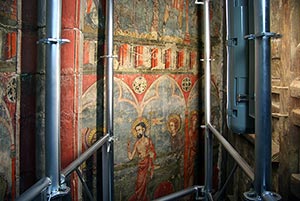Cultural heritage of Ororbia
San Julián Parish: the mural paintings by Juan Oliver
The mural paintings that decorate the chancel were discovered in 2007, after centuries hidden and preserved by the main altarpiece. They are a total of sixteen scenes organized in three registers that narrate the passion, death and resurrection of Christ (lower), his birth and infancy (intermediate) and it seems that the final judgment (upper). The best preserved represent the holy burial, the resurrection and the three Marys before the tomb. Among those partially preserved or in poor condition, the apocryphal miracle of the sunbeam stands out, a rare iconography, with the infant Jesus riding on a sunbeam while his friends fall to the ground as they try to imitate him.
The style is undoubtedly the same as that of the mural in the refectory of the cathedral of Pamplona -today in the Museum of Navarre-, a work by Juan Oliver around 1335. This artist, trained at the papal court of Avignon, is considered one of the most important figures of Gothic line painting in Europe. Indeed, the stamp of Juan Oliver can be seen in the clarity of the composition of the scenes, the neutral colored backgrounds, the gothic architectures as a frame, the employment of color ranges to show Issue, the agile and precise drawing line, and the subject of figures, with elegant attitudes and gestures and very characteristic physical features: aquiline noses, beards and curly hair, almond-shaped and expressive eyes and intensely red lips.
These paintings are another link between the church of Ororbia and the work of the cloister and rooms of the cathedral of Pamplona, as well as the architecture and the sculptural decoration. It is worth asking about the reasons that led to entrust its execution to the best painter of the time and under a cultured and unique iconographic program. The manager could have been a canon named Gonzalo Martínez de Ororbia, who is known in the first quarter of the 14th century. As it is known, in the Age average toponymic surnames were used to show the origin of their bearer.
The effort made in the study and restoration of the mural paintings has not been culminated with an action that facilitates their contemplation by the public, guaranteeing at the same time the conditions to avoid their deterioration. The presbytery is large enough to consider moving the main altarpiece forward and thus create a large space in the chancel to allow access and enjoyment of visitors, a solution carried out in similar cases. For the moment, only researchers can enter the area behind the altarpiece, where scaffolding has been erected to facilitate close analysis of Juan Oliver's painting technique. Precisely the fact that they remain in situ is what makes these paintings an exceptional work, since it has been possible to reconstruct step by step the painter's process of work .
ALEGRÍA SUESCUN, D., Flour Mills of Ororbia. Historical-documental study, Concejo de Ororbia, 2015.
GUIJARRO SALVADOR, P., Ororbia: a thousand years of history, Concejo de Ororbia, Kybse, 2015.
MARTÍNEZ ÁLAVA, C. J., TARIFA CASTILLA, M.ª J. and LATORRE ZUBIRI, J., La iglesia de San Julián de Ororbia. History and restoration, Concejo de Ororbia. Foundation for the Conservation of the Historical Heritage of Navarre. Graftech Ibérica, 2014.
ZUBIAUR CARREÑO, F. J., "Catalog de miradas. La Navarra que fotografió Nicolás Ardanaz", in Ricardo Fernández Gracia (coord.), Pvlchrvm: Scripta varia in honorem M.ª Concepción García Gainza, Gobierno de Navarra. University of Navarra, 2011, pp. 838-846.
transcript del Asilo San José: file Contemporáneo de Navarra/Vivienda/1116846.











